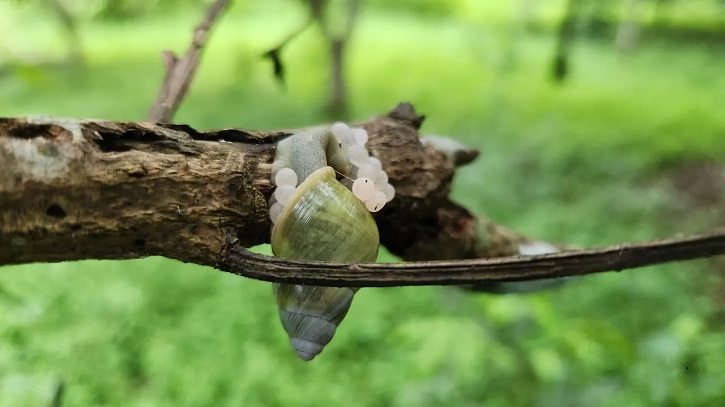
A research team from Rajshahi University (RU) has made a groundbreaking discovery in the field of biodiversity with the identification of unique reproductive behavior in a rare tree-dwelling snail species, Amphidromus globonevilli. The findings, recently published in the international scientific journal Folia Malacologica, mark the first documented evidence of this species laying eggs entirely within trees, a revelation that opens new frontiers in South Asian biodiversity research.
The species, commonly known as a tree snail, is classified as arboreal and has been found across parts of Bangladesh, Thailand, and Myanmar. Until now, there had been no verified data on its egg-laying patterns. The discovery was made during a five-day field survey in September and October 2024 across Chattogram, Khagrachari, Rangamati, and Bandarban districts.
The study was led by Professor Dr. Mohammad Shahriar Shovon, head of the Molluscan Research Laboratory at RU’s Department of Biochemistry and Molecular Biology, in collaboration with Dr. Takumi Saito of Vrije University, Netherlands. Other members of the research team include Dr. T.S. Rupmoy Tanchangya from Mohalchhari Upazila Health Complex, and postgraduate students Rahim Badsha and Zayed Hasan from RU.
According to the researchers, Amphidromus globonevilli lays clusters of 10 to 50 pinkish-white eggs inside small cavities in trees. In some cases, eggs were found attached to the snail’s shell or exposed outside the cavity. These observations suggest that the species may complete its entire life cycle within the trees, a behavior not previously recorded for any arboreal gastropod.
The snails were observed laying eggs not only on mango trees but also on jackfruit and other tree species. This represents a shift from earlier studies, which indicated that the species laid eggs underneath leaves. The current study documents a novel nesting pattern within tree hollows.
Research associate Rahim Badsha noted that field-based biological research remains limited in Bangladesh, with most academic focus directed toward publication metrics rather than ecological discovery. The work led by Dr. Shovon, supported by international collaboration, is seen as a significant step in reversing that trend. The team has already discovered five new species of tree snails and published one unprecedented behavioral observation, with further studies underway.
Despite the success, the team cautioned that such research initiatives are vulnerable to funding shortages. They stressed the urgent need for institutional and governmental support to ensure the continued study and conservation of endangered species in the region.
Dr. Shahriar Shovon emphasized the rarity of this species and the challenge of locating its nesting sites within extremely small cavities. He noted that the reproductive behavior discovered through this research could be critical in shaping future conservation strategies. Moreover, it provides vital insight into the behavioral evolution and ecological diversity of terrestrial gastropods in South Asia.
Under Dr. Shovon's leadership, the Molluscan Research Laboratory has also achieved the world’s first successful artificial breeding of tree snails, a milestone that marks significant progress in conserving this endangered group of organisms.





